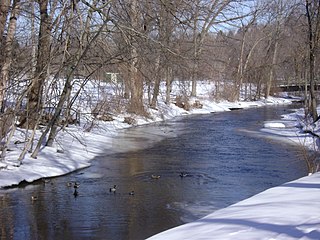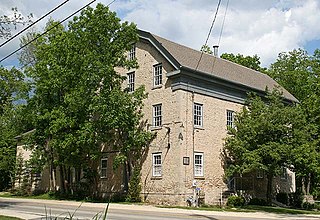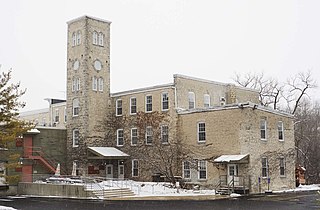
Ozaukee County is a county in the U.S. state of Wisconsin. As of the 2020 census, the population was 91,503. Its county seat is Port Washington, making it one of three Wisconsin counties on Lake Michigan not to have a county seat with the same name. Ozaukee County is included in the Milwaukee–Waukesha–West Allis, WI Metropolitan Statistical Area.

Worsted is a high-quality type of wool yarn, the fabric made from this yarn, and a yarn weight category. The name derives from Worstead, a village in the English county of Norfolk. That village, together with North Walsham and Aylsham, formed a manufacturing centre for yarn and cloth in the 12th century, when pasture enclosure and liming rendered the East Anglian soil too rich for the older agrarian sheep breeds. In the same period, many weavers from the County of Flanders moved to Norfolk. "Worsted" yarns/fabrics are distinct from woollens : the former is considered stronger, finer, smoother, and harder than the latter.

Cedarburg is a town in Ozaukee County, Wisconsin, United States, and is in the Milwaukee metropolitan area. The town was created in 1849 and at the time of the 2020 census had a population of 6,162.

Cedarburg is a city in Ozaukee County, Wisconsin, United States. Located about 20 miles (32 km) north of Milwaukee and in close proximity to Interstate 43, it is a suburban community in the Milwaukee metropolitan area. The city incorporated in 1885, and at the time of the 2020 census the population was 12,121.

Grafton is a village in Ozaukee County, Wisconsin, United States. Located about 20 miles (32 km) north of Milwaukee and in close proximity to Interstate 43, it is a suburban community in the Milwaukee metropolitan area. The village incorporated in 1896, and at the time of the 2010 census the population was 11,459.

The Montgomery Worsted Mills, known today as Montgomery Mills, is along the Wallkill River at the end of Factory Street in the Orange County village of Montgomery, New York. It was one of the earliest efforts to harness the river for industrial purposes.
The American Woolen Company is a designer, manufacturer and distributor of men’s and women’s worsted and woolen fabrics. Based in Stafford Springs, Connecticut, the company operates from the 160-year-old Warren Mills, which it acquired from Loro Piana SpA in June 2014.

Cedar Creek is a 53-kilometre-long (33 mi) stream in southeastern Wisconsin in the United States. The Cedar Creek watershed is a 330 km2 (127 mi2) sub-basin of the larger Milwaukee River watershed.

The Bernat Mill, also known as Capron Mill, and later Bachman Uxbridge Worsted Company, was an American yarn mill in Uxbridge, Massachusetts, that was for the most part destroyed by fire on July 21, 2007.

Washington Avenue Historic District is the historic center of Cedarburg, Wisconsin, the location of the early industry and commerce that was key to the community's development. The historic district was listed on the National Register of Historic Places (NRHP) in 1986.

The Cedarburg Mill is a former gristmill in Cedarburg, Wisconsin that is listed on the U.S. National Register of Historic Places. Located the on Cedar Creek, the building was constructed in 1855 by Frederick Hilgen and William Schroeder to replace a smaller wooden mill from the 1840s. At the time of its construction, the five-story structure was the tallest building in Cedarburg.

The Wayside House is a historic house located in Cedarburg, Wisconsin. It was built by Frederick Hilgen, who later co-owned the Cedarburg Mill, and is considered the father of Cedarburg. It was added to the National Register of Historic Places on March 17, 1982.

Hamilton is an unincorporated community located in the Town of Cedarburg, Ozaukee County, Wisconsin, United States. Much of the community is part of the Hamilton Historic District, a site listed on the National Register of Historic Places. The NRHP-listed Concordia Mill is also located in the community.

The Winooski Falls Mill District is located along the Winooski River in the cities of Winooski and Burlington, Vermont, in the United States of America. It encompasses a major industrial area that developed around two sets of falls on the river in the 19th century.

The Cedarburg Woolen Co. Worsted Mill is a former woolen mill on the Milwaukee River in Grafton, Wisconsin. In the late-1800s, the Cedarburg Woolen Company in neighboring Cedarburg decided to expand their production by opening a second mill.

The Concordia Mill is a former gristmill on Cedar Creek located in Hamilton, Wisconsin, United States. The limestone mill was built in 1853 by Edward H. Janssen and his brother, Theodore, along with a Mr. Gaitsch with locally quarried limestone. In 1881, the mill's dam washed out during heavy spring flooding and was rebuilt sometime later. The mill operated until World War II when it was converted into a distillery that operated for several years. On April 26, 1974, it was added to the National Register of Historic Places, and the surrounding area, known as the Hamilton Historic District was added to the NRHP two years later.
Pranker Mills, also known as the Iroquois Mills, is a former American textile mill located in Saugus, Massachusetts that was in operation from 1822 to 1915.

The Columbia Historic District is a neighborhood in Cedarburg, Wisconsin, that is listed on the National Register of Historic Places. At the time the district was listed on the register, its contributing properties included 128 historic homes, one church, and eighty-seven historic outbuildings, including garages and barns, all constructed between 1844 and 1938. The district also contained several dozen buildings that do not contribute to the historic district, including modern homes from the post-war era as well as modern garages and other additions to historic properties.
Johann Friedrich "Frederick" Hilgen was a German American immigrant, miller, and Wisconsin pioneer. He is known as the "father" of Cedarburg, Wisconsin, and was responsible for the construction of the historic Cedarburg Mill and the Hilgen and Wittenberg Woolen Mill. He also represented Ozaukee County in the Wisconsin Senate during the 1860 legislative session.
















